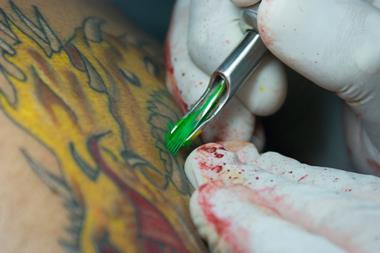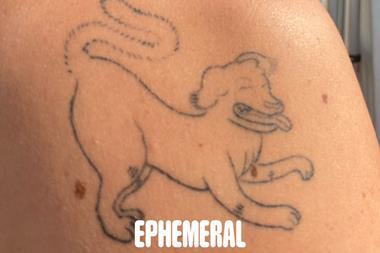‘There are a lot of questions around safety in tattoos, and we’re nowhere close to answering that,’ says John Swierk, who runs an inorganic chemistry research group at Binghamton University in the US. ‘The focus here is just to start with a simple question of whether labelling is accurate, because if you want to track down adverse events, you have to know what’s in the ink to start working backwards.’
Swierk’s group works on a broad portfolio of research, including photoredox catalysis. But about four years ago he became intrigued by the idea of using tattoos to monitor health and began to wonder why light seems to cause tattoos to fade. There wasn’t a clear answer, so he built a research programme to study the photochemistry of tattoos and brought in Kelli Moseman, who is now a sixth year PhD student in his lab, to help with that effort.

‘I thought it was super relevant research,’ Moseman recounts. ‘My mom had just gotten her first tattoo, so it all tied together,’ she adds. Moseman has been researching tattoo inks ever since.
‘Very early on Kelli would bring me results and say, “Look at what’s in this ink, do you think this is a breakdown product?”’ Swierk recalls. The scientific literature at that time, primarily from Europe, had hinted at issues with tattoo inks so he decided to back up and examine their composition.
A couple of years ago Swierk presented preliminary results from his team’s earlier analysis of tattoo inks manufactured in the US. He’d found concerning ingredients that were not listed by manufacturers, including azo-containing dyes – which can degrade into carcinogenic aromatic amines – in 23 of 56 tattoo inks analysed. Now, Swierk’s team has completed a study on a much wider sample of tattoo inks.
If we don’t understand what’s in tattoo inks, then we can’t adequately start asking questions about safety
Tattoo ink is comprised of a pigment, which provides the colour and stays in the skin long-term, and a carrier package, which is usually a mix of alcohol and water. The pigment is suspended in the carrier package, and in this new study the Binghamton researchers separated the two components and used a combination of nuclear magnetic resonance and mass spectrometry to analyse both and determine whether their ingredients matched their labels.
The completed study closely examined tattoo inks from nine US manufacturers,1 including large global companies and smaller producers, and discovered that for 83% of these inks – 45 out of 54 – there were major discrepancies between their ingredients and their labels. For example, they found unlisted polyethylene glycol in more than half of the inks.
Allergens and antibiotics
Propylene glycol is another ingredient Swierk and colleagues found in many of the inks that wasn’t on the labels. This common emollient and emulsifier is generally considered safe but the American Contact Dermatitis Society did name it their ‘Allergen of the Year’ for 2018. Additional unlisted contents the researchers uncovered included an antibiotic used to treat urinary tract infections called hexamethylenetetramine, a common moisturiser in cosmetics and lotions named dodecane, and the aromatic ether 2-phenoxyethanol.
‘The fact that we found a lot of unlisted things in nearly 90% of the inks raises some eyebrows about the accuracy of the labelling and whether or not people – tattoo artists and their clients – are really adequately informed about the inks that they’re using,’ Swierk tells Chemistry World.
The team could not determine whether the unlisted ingredients were added intentionally to the inks, or the manufacturer received incorrectly labelled or contaminated materials. ‘Your typical tattoo artists, even many of these ink manufacturers, don’t have access to the expertise and the equipment that we have access to that can really pinpoint these things,’ Swierk states. ‘It can be a powerful tool for holding businesses accountable for what they’re putting in their products.’
He suggests that it’s unlikely the discrepancies his team identified are restricted to the subset of tattoo inks they studied, and asserts that his results should spur tattoo ink manufacturers to implement changes.
Informed choices
Tattoo clients deserve to make informed choices and tattoo artists deserve to have information to best serve their customers, Swierk argues. ‘If they want to get a tattoo with polyethylene glycol in it, or propylene glycol or whatever, that’s fine – that’s their choice and everybody should have that choice,’ he continued. ‘But when it’s not listed and not disclosed then clients and artists don’t get to make that choice, and that’s where we think there’s a problem.’
Moseman echoes Swierk’s sentiments. ‘It’s about giving knowledge and information to the individuals – tattoo artists and their clients – and letting them make decisions for themselves,’ she says.
‘If we don’t understand what’s in tattoo inks, then we can’t adequately start asking questions about safety,’ Swierk says. That’s why he plans to add his lab’s findings to his What’s In My Ink? website once they are peer-reviewed. ‘As we characterise tattoo inks, people can go and see what we’re finding,’ he explains.
Currently, the website contains some of Swierk’s previously published data. His latest findings, along with results from subsequent studies, will be entered soon. Swierk also hopes that other university chemistry labs can contribute to the website, and maybe flag findings that require further evaluation. ‘Can we crowdsource ink characterisation and create a tool that maybe has a degree of accountability for manufacturers and can inform clients and tattoo artists?’ he wonders.
Neither Swierk nor Moseman have any tattoos themselves. ‘I still want a tattoo,’ says Moseman. ‘We’re not anti-tattoo,’ Swierk adds. ‘While there are potential safety concerns around some of the things we found in the inks, I think that the key [word] to emphasise is “potential” – there’s a lot of research that’s left to be done.’
References
1 K Moseman et al, Anal. Chem., 2024, 96, 3906 (DOI: 10.1021/acs.analchem.3c05687)



















No comments yet